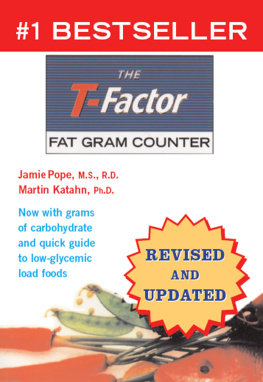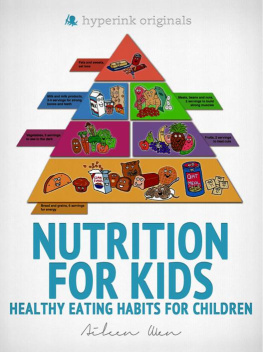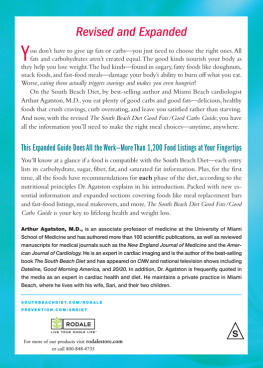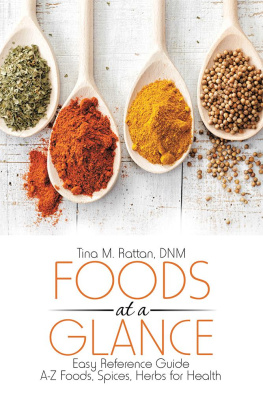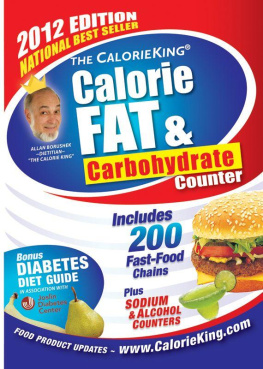The T-Factor
QUICK GUIDE
to Low-Glycemic-Load
Carbohydrate Foods
Many people who have difficulty keeping their appetite under control and managing their weight report that it is helpful to design their diets to prevent the rapid rise in blood sugar that may occur after eating certain carbohydrate foods.
The carbohydrate foods in this Quick Guide have been selected on the basis of the glycemic load (GL), which is the average elevation in blood sugar in the two hours following consumption of a normal portion of a carbohydrate food. The GL is of much greater practical value than the glycemic index (GI), since that is based on a standard laboratory test reaction to a 50-gram load of carbohydrate. People do not normally eat a 50-gram load of any single carbohydrate except in a laboratory situation.
Monitoring carbohydrate intake is especially important for diabetics. If you think you have a problem maintaining control over your blood sugar, consult your doctor for advice on how to deal with it. In general, the best advice for controlling blood sugar, as well as for successfully managing weight, can be outlined in several simple steps:
- Emphasize fiber-rich whole grains (whole-grain bread, pasta, cereals, and brown rice).
- Cut out sugar-rich junk food and increase fresh fruits and vegetables.
- Include a protein food or a bit of fat in meals with carbohydrate foods (protein and fat slow digestion and significantly reduce the overall GL of the meal).
- A garden salad with a dressing containing vinegar or lemon juice will also lower the overall GL of a meal.
- Eat several small meals and snacks during the day to keep insulin levels and appetite under control.
- If you are in good health, aim for about 25 percent of your calories in fat and get active! Physical activity helps control blood sugar. Aim for at least 40 minutes a day in some form of moderate activity that involves the major large muscle groups of your body (e.g., walking, water aerobics, strength training).
All of the low-glycemic-load carbohydrates in the following list meet T-Factor guidelines for being relatively low in fat while being high in nutritional value.
If you are in treatment for any medical condition, check with your physician about the appropriate level of fat in your diet, as well as the appropriate type and amount of physical activity. This is particularly important if you are diabetic. When it comes to weight maintenance, people who have lost significant amounts of weight and have been successful in keeping it off for five years or more report averaging 80 minutes a day in moderate to vigorous physical activity.
BEANS AND LEGUMES
baked beans, canned
beans, all types, dried, boiled
black-eyed peas
chickpeas (garbanzo beans), boiled
lentils
split peas
BEVERAGES
apple juice
carrot juice
grapefruit juice
orange juice
pineapple juice
smoothies, w/fruit and soy
tomato juice
BREADS
barley
buckwheat
flatbread, Indian whole wheat
flatbread, Middle Eastern
multigrain
oat, regular
oat branrye/pumpernickel
sourdough wheat
taco shells, cornmeal based, baked
tortilla, wheat
whole-wheat
CAKES
pound
sponge
CEREALS
All-Bran
Bran Buds
Bran Flakes
Cheerios
Corn Bran
Grape-Nuts
Grape-Nuts Flakes
Just Right
Mini-Wheats, whole wheat
Multi-Bran Chex
Nutrigrain
Oat Bran Hot Cereal
Puffed Wheat
Raisin Bran
Shredded Wheat
Special K
Team
Total
CONVENIENCE FOODS
pizza, vegetarian, thin crust
spaghetti w/meat sauce
sushi
CRACKERS
Breton wheat crackers
Norwegian crispbread
rye crispbread
Stoned Wheat Thins
DAIRY PRODUCTS
ice cream, reduced and low fat
milk, low fat milk, chocolate, low fat
pudding, low fat
soy milk
tofu-based frozen dessert, chocolate
yogurt, regular and lite varieties
FRUIT
apples
apricots
bananas
cantaloupe
cherries
figs, dried
grapefruit
grapes
kiwi fruit
mango
oranges
papaya
peaches, fresh
pears, canned in juice
pears, fresh
pineapple
plums
prunes, pitted
strawberries
watermelon
GRAINS
brown rice
bulgur
long-grain and wild rice
wheat-based pastas and noodles
MUFFINS
bran
SNACK FOODS
popcorn
SOUPS
black bean
lentil
split pea
tomato
VEGETABLES, NONSTARCHY
All nonstarchy vegetables have so little impact on blood sugar that the GI and GL have not been measured
asparagus
broccoli
Brussels sprouts
cabbage
carrots
cauliflower
green beans
greens (turnip, kale, mustard)
onions
peppers
salad greens
spinach
summer squash, all varieties
tomatoes
VEGETABLES, STARCHY
green peas
potatoes, mashed
pumpkin
yam
Net Carbs: The Lowdown
There are no government-approved standards for labeling products described as no carb, low-carb, low net carb, reduced carb, or smart carb. The Food and Drug Administration does permit manufacturers to use a net carbs definition, which is calculated by subtracting the fiber content (fiber contains carbohydrates) from total carbohydrates to produce a net carb count. Some manufacturers also subtract sugar alcohols, such as isomalt, lactitol, mannitol, xylitol, and sorbitol, from the carb total in calculating net carbs. But this can be misleading since these sugar alcohols still provide calories, although less than the 4 per gram in sugar. Since sugar alcohols pass through the large intestine and are digested by fermentation, some can cause digestive problems such as gas and diarrhea. For practical purposes, simply subtracting fiber count from total carbohydrate will result in a close approximation of net carbs.
A HANDY GUIDE TO JUDGING PORTION SIZES
Serving Size | Equivalent to or Approximates |
3 oz. meat, poultry, or fish | a deck of cards or a cassette tape |
1 cup yogurt, pudding, or ice cream | a baseball or tennis ball |
1/2 cup chopped vegetables | three regular ice cubes |
1 cup cooked vegetables | a fist |
1/2 cup grapes (about 15) | a standard ice-cream scoop |
1 cup fruit | a baseball or tennis ball |
1 medium potato | a computer mouse |
1/2 cup potatoes, pasta, or rice | a baseball or tennis ball |
1 standard bagel | a hockey puck |
1 cup chopped, fresh leafy greens | four lettuce leaves |
2 T butter or cream cheese | a golf or Ping-Pong ball |
2 T peanut butter | a golf or Ping-Pong ball |
2 T salad dressing or mayonnaise | a golf or Ping-Pong ball |
1 t butter, margarine, or mayonnaise | top joint of average-size thumb |
1 oz. cheese | four dice or a tube of lipstick |
1 oz. sliced cheese | a 3.5-inch computer disk |
1 standard pancake | a CD |
1 oz. small snack food (hard candy, nuts) | fits into a closed fist (average hand) |
|

